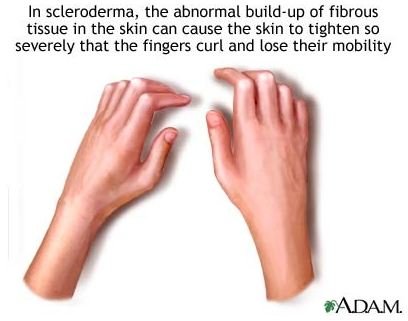Alternative Medicine: Scleroderma Natural Treatments
Scleroderma comes from the Greek words skleros, meaning hard, and derma, meaning skin. It is an autoimmune disease of the connective tissue. It is categorized as a rheumatologic disorder and is characterized by fibrosis in the skin and internal organs, causing a thickening and hardening of the involved areas. There are two types: localized and systemic. Localized affects only the skin, usually the hands and feet. Systemic affects large areas of the skin and may affect internal organs. Localized rarely becomes systemic or causes serious complications. Systemic can result in damage to organs (lungs, heart, kidneys), cause arthritis, inflame muscles and slow gastrointestinal tract contraction - it can be fatal.
Scleroderma is a rare and progressive disease that is not contagious. It affects women more than men and normally occurs between the ages of 30 and 50. It can affect one’s ability to accomplish everyday tasks, and can have a big impact on a person’s self-esteem. There is no cure. Conventional treatment includes penicillamine and other immunosuppressive drugs, glucocorticoids and cholchicine. According to Alan R. Gaby, MD, none of these have a high degree of efficacy. However, there are several natural treatments that show promise in treating this condition.
Para-Aminobenzoic Acid
Para-aminobenzoic acid (PABA) is a naturally occurring substance found in the folic acid vitamin and some foods, including meat, milk, eggs and grains. It appears to have an antifibrotic action because of its beneficial effect in people with Dupuytren’s contracture and Peyronie’s disease - other connective tissue disorders.
In 1948, it was reported to be an effective treatment for scleroderma when given as potassium para-aminobenzoate (KPAB). Over time, the skin became softer and thinner, with improved range of motion.
In 1961, data showed that 97 of 104 patients had moderate to considerable improvement of the skin after being treated with 12 grams of KPAB a day. Some had a complete remission, while others had to continue treatment indefinitely. In the 1980s, according to a retrospective analysis of 390 patients, those who took KPAB had a much slower rate of decline in pulmonary function and a significantly higher rate of survival than those who did not receive it.
PABA is FDA-approved for scleroderma, but not all evidence shows it being beneficial.
If taken correctly, PABA appears safe. Possible side effects include upset stomach, loss of appetite, nausea, vomiting and diarrhea. High doses, more than 12 grams a day, should be avoided because it can cause liver, kidney and blood problems. Pregnant women, women who are breastfeeding and people with kidney disease should not use.
Vitamins D & E
According to a few different studies, calcitriol - a biologically active form of vitamin D - has been shown to improve skin thickness, skin extensibility and joint mobility. Some studies showed no improvement. Calcitriol is expensive, and can cause hypercalcemia (high levels of calcium in the blood), hypercalciuria (high levels of calcium in the urine) and other side effects requiring close monitoring. Although not studied, vitamin D3 (cholecalciferol), which is less expensive, might be a viable alternative to calcitriol
Vitamin E, a powerful antioxidant, may inhibit events involved in the autoimmune process and may have an antifibrotic action. One patient, a 45 year old male with Raynaud’s phenomenon and ulceration and gangrene of the fingertips, was treated successfully with oral (800 IU a day) and topical (50 IU per ml two times a day) treatments. After two weeks, he had improvement in pain, and within one month, his fingers were almost completely healed.
Omega-3
Omega-3 may benefit those who suffer from sensitivity to cold in the hands and feet (Raynaud’s phenomenon). This fatty acid can help improve circulation, and according to a few studies, may improve tolerance to cold. Salmon, mackerel, tuna and other cold water fish are excellent sources of omega-3. Supplements are also available. People who take medicine to thin the blood should talk to their doctor before taking supplements.
Bromelain and Turmeric
Although bromelain and turmeric are not a specific treatment for scleroderma, they may help reduce inflammation and pain when given alone or combined together. Both may increase the risk of bleeding, so those taking blood-thinning medications should consult their health care provider first before using.
Estriol
Conditions sometimes improve in pregnant women whose estriol levels rise during the end of pregnancy. Skin softening and increased mobility were noted in two women with scleroderma (ages 48 and 59 years) after being treated with estriol. Until more is known, this treatment may be best used for women with an estrogen deficiency.
Other
Other natural treatments that may help include:
- evening primrose oil - may improve skin texture and reduce pain in the hands and feet
- S-adenosylmethionine - may reduce thickness of the dermal layer
- N-acetylcysteine - may reduce the frequency and severity of attacks of Raynaud’s phenomenon
- gotu kola - benefits blood vessels and improves circulation
- acupuncture - may improve circulation, help heal fingertip ulcers, relieve pain and reduce the formation of fibrous tissue
- massage - improves circulation
- physical therapy - can help improve strength and mobility
Before using any alternative medicine for scleroderma, talk to your doctor first.
References
Mayo Clinic: Scleroderma - https://www.mayoclinic.com/health/scleroderma/DS00362
A Natural Healing Center: Natural Remedies for Scleroderma - https://www.anaturalhealingcenter.com/documents/Thorne/articles/scleroderma11-3.pdf
Web MD: Para-Aminobenzoic Acid (PABA) - https://www.webmd.com/vitamins-supplements/ingredientmono-1004-PARA-AMINOBENZOIC%20ACID%20%28PABA%29.aspx?activeIngredientId=1004&activeIngredientName=PARA-AMINOBENZOIC%20ACID%20%28PABA%29
University of Maryland Medical Center: Scleroderma - https://www.umm.edu/altmed/articles/scleroderma-000147.htm
Image courtesy of the National Library of Medicine (NLM)
Disclaimer
Please read this disclaimer regarding the information contained within this article.
